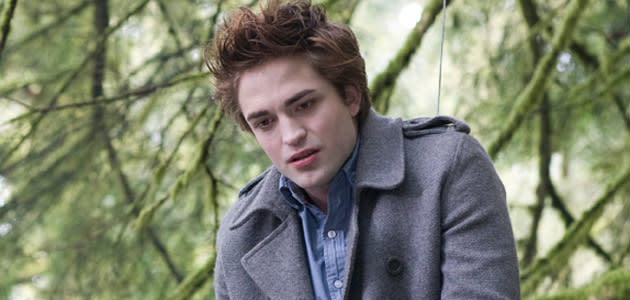 Yahoo UK Movies Features
Yahoo UK Movies FeaturesA history of the movie vampire
From downright scary to wimpy and sparkly: here's how the cinematic blood sucker got lame
You may have heard that a little film called ‘The Twilight Saga: Breaking Dawn Part 1’ is coming out this week. Regardless of your feelings towards the franchise, everyone loves a good vampire move.
But how close is Cullen and co. to the vampires of yesteryear? Here’s a look at the history of blood suckers on the silver screen.

Nosferatu (1922)
The original and most iconic movie vampire is Max Schreck as Count Orlok. As pale as the moon with pointed ears, big claws and a sunken face, Orlok is still creepy today despite the limitations of 1920s make up and effects. Most terrifying: when he glides up stairs without moving his legs. ‘Nosferatu’ was (unofficially) based on Bram Stoker’s classic 1800’s novel ‘Dracula’ and his estate sued successfully and destroyed many copies. Some survived and the restored version became a classic.
[Review: 'The Twilight Saga: Breaking Dawn Part 1']
Dracula (1931)
The first official adaptation of Stoker’s novel, ‘Dracula’ was a commercial smash that truly ushered in the vampire sub-genre. This first official movie incarnation of the famous Count introduced the dodgy Hungarian accent, natty suit and unsettling charm that terrified audiences when it was first released. It’s a bit creaky today, mind.

Hammer Film’s Dracula (1958)
Christopher Lee’s portrayal of Count Dracula is probably more famous today and is also the actor’s most iconic role. Hammer Film’s take on the story reinforced Dracula’s sunlight allergy (first seen in ‘Nosferatu’) by killing off their lead vamp with solar rays. It’s now an accepted part of vampire lore.
Fright Night (1985 & 2011)
Bringing vampires into the present day was one thing, but a vampire called ‘Jerry’?! Despite the name, these two horrors won many fans and did well at the box office. The key to success was remaining true to what makes vampires terrifying, despite the change in scenery. So themes of sexuality and lust are present and correct, with the stars (Chris Sarandon and Colin Farrell) oozing charm and terror.
[See also: The 'Twilight' story so far... in three minutes!]
The Lost Boys (1987)
Another contemporary take of vampires, ‘The Lost Boys’ did teenage vampires right, keeping them as the villains unlike a certain recent series. Kiefer Sutherland is the most recognisable name on vamp duty here, playing a similar bad boy, gang leader role that we first saw in ‘Stand By Me’.
Bram Stoker’s Dracula (1992)
The 90s was a good decade for vampire films. Kicking off the fun was Francis Ford Coppola’s adaptation of the famous novel. Touted as the definitive re-telling it had some big names attached, including Keanu Reeves (who was admittedly terrible), Anthony Hopkins and Gary Oldman as the titular blood sucker.

Interview with the Vampire (1994)
If you want sexy vampires then this is how you do it - cast Brad Pitt and pre-weird Tom Cruise. The literal story of, erm, an interview with a vampire (Brad Pitt), who describes his life to Christian Slater’s reporter. Cruise’s casting was criticised by author Anne Rice, but after seeing the film she wrote him a public letter of apology.
From Dusk Till Dawn (1996)
Time for something completely different. Enter Robert Rodriguez and Quentin Tarantino who respectively directed and wrote this unashamedly fun action horror with all the telltale signs of both men’s style. For the first 40-or-so minutes it was a crime drama, then out of nowhere vampire demons showed up, and all hell breaks loose... literally.
[See also: 'Twilight' 'rip-offs']
Blade (1998)
The end of the 90s saw the rise of the now all-powerful comic book movie, which was helped by this adaptation of one of Marvel’s lesser known heroes – Blade. Wesley Snipes played the eponymous half-vampire, vampire hunter and confidently spent the film slicing undead baddies in half. Sequels and tax dodging followed.

Twilight (2008)
When vampires stopped being scary. With the arrival of Stephenie Meyer and her trilogy of books, out were the brutal, predatory vampires of the past, in were sparkly-faced hunks with sparkly skin and more teen angst than a My Chemical Romance mosh-pit. Horror fans were outraged, but youngsters loved it.
Let the Right One In (2008)
Or the ‘anti-Twilight’, here’s an interesting, compelling and Scandinavian take on vampires from director Tomas Alfredson (who went on to direct this year’s ‘Tinker, Tailor, Soldier, Spy’). The film tells the tale of 12-year-old boy Oskar who falls in love with an odd, interesting girl called Eli. She is a vampire. The concept of first loves intertwined with vampirism is a strange one but ‘Let the Right One In’ remains a modern classic, earning it a lesser Hollywood remake; the true sign that a foreign film has been a success.

 Yahoo Movies
Yahoo Movies 
